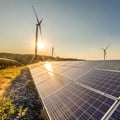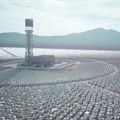
Source: Gallo/Getty
While there is consensus that new electricity generating plants are urgently needed to minimise power outages, there are radically differing views on how this is best achieved. The official electricity plan approved three years ago is already out of date. Its implementation is furthermore two years behind schedule.
One widely promoted view is that increasing electricity generating capacity requires grand-scale new renewable energy developments. In 2020 the electricity generated from renewables amounted to a mere 10.5% of the South African national total. This will have grown to about 11.5% as more plants have been completed.
The country’s power generation is still dominated by coal. And it’s lagging far behind the global trend towards clean energy.
Most people associate renewable energy exclusively with wind and solar energy, but it includes all technologies that don’t process non-replaceable fossil fuels. Fossils include coal, oil, gas and minerals (for example the uranium used in nuclear energy).
Hydropower stations, which extract electricity from the downhill flow of water, are a renewable energy source. This is the major source of electricity in water-rich countries like Norway, but only a limited option in drier climates. When water needs to be retained in dams during times of drought, then no electricity production is possible.
As South Africa is drought-prone, a major increase in local hydropower generation (currently at 3% of the total) is not feasible.
Other renewable energy technologies like geothermal and tidal power generation work in select localities that are not common in South Africa.
This leaves wind and solar. These sources currently make up about 8% of South Africa’s energy mix.
Wind and solar power
Wind and solar power are very attractive because:
- South Africa has some of the best solar and wind resources in the world. Solar and wind plants already produce electricity very effectively in many cloudier and less windy environments than South Africa.
- Solar and wind plants can be built in less than two years. But the pre-construction processes – bidding, approvals and such – stretch completion times by at least another year.
- Running costs are very low as there are effectively no fuel purchases. Prices of solar and wind technology have dropped very sharply in the past 10 years. The cost – including building and other expenses – of solar and wind electricity is now well below the corresponding expenses for electricity from gas, nuclear and even coal.
- Their extremely low carbon emissions mitigate global warming and makes solar and wind energy attractive for investors.
Solar and wind power, however, have obvious drawbacks. The main one is that their operational capacity entirely depends on the weather. Furthermore, solar energy production is linked to the day-night cycle, with maximum efficiency around noon. This doesn’t coincide with the electricity demand peaks in the early morning and early evening.
Could renewable energy dominate?
The ideal of a national electricity generation network without greenhouse gas emitting coal, gas plants and radioactive waste generating nuclear plants has practically already been achieved in a number of medium-sized countries such as Costa Rica, Iceland and Paraguay. But these mainly rely on hydropower.
Several larger countries, such as Germany, now generate over half of their electricity from renewables. More countries are setting road-maps to achieve 100% renewable electricity.
In theory, with South Africa’s wind and solar resources superior to other countries with 100% renewable electricity ambitions, this should be a relatively easy target to reach. But other countries are often grid connected to neighbours with significant power production. This means they can draw on these when weather conditions are unfavourable.
That is why a renewable electricity system can’t become the dominant power source in South Africa until electricity storage technologies become practical and economical.
A target of 50% electricity from renewables is, however, perfectly feasible. It’s the minimum that the country should aspire to. Even the 2019 electricity plan projected this would happen by 2050.
Renewable energy in South Africa
Considering the climatic advantage, the fraction of electricity generated from renewable energy technologies is surprisingly low. Despite this small fraction, there is significant hostility to renewable developments in some quarters. Some sectors have interests in maintaining the coal-dominated status quo.
In assessing the contribution of renewable energy sources to the electricity supply it’s important to distinguish between power (the rate at which it is produced at any particular moment) and energy (the total produced over an extended time period).
In view of the variability of the wind strength and the intermittence of sunlight, these technologies only occasionally produce power at top capacity. In typical South African conditions, a 100MW solar or wind plant only generates about a third of the energy of a functioning 100MW coal plant.
Thus the recently announced construction of an additional 2,600MW of wind and solar farms will effectively only produce electricity equivalent to about 900MW averaged over a day – this equates to only about 15% of the worst power shortfalls experienced to date.
Overcoming the present 6,000MW power shortages therefore requires approximately 15,000MW of new solar and wind plants. The continuing deterioration in the efficiency of the large coal power plants means that the actual need for new renewable generating capacity in the next five years is closer to 20,000MW. In the current electricity plan, this scale of renewable energy developments was projected over a time span of 10 years.
There is now an increasing recognition that the energy crisis must be treated as such. A speedy renewable energy boom is the only way to escape the downward spiral in power cuts in the medium term.
President Cyril Ramaphosa’s announcement that drastic steps are imminent to combat the electricity crisis are likely to amount to a major drive towards more renewables. This will not unduly place the South African electricity supply at the mercy of the weather or developments in storage technology, as the contribution of electricity from coal would still amount to around 60%.
This article is republished from The Conversation under a Creative Commons license. Read the original article.

















































